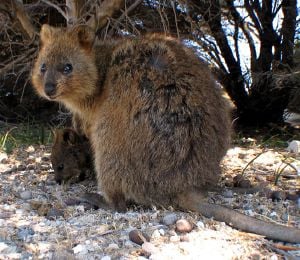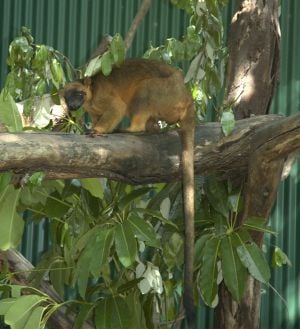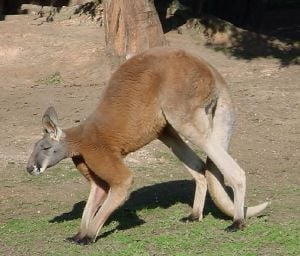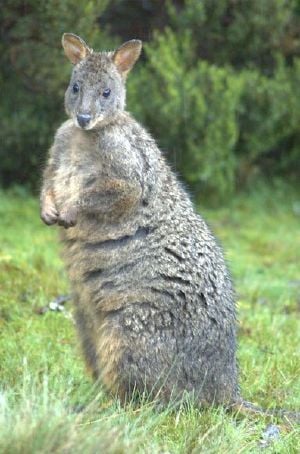Macropod
| Macropods
| ||||||||||||||
|---|---|---|---|---|---|---|---|---|---|---|---|---|---|---|
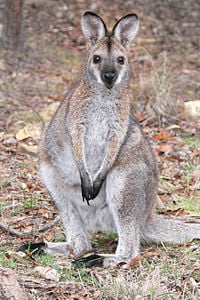 Red-necked wallaby
| ||||||||||||||
| Scientific classification | ||||||||||||||
| ||||||||||||||
|
Macropod is the common name for any of the terrestrial and arboreal marsupials comprising the family Macropodidae, characterized by strong hind legs, long tails, thin necks, and prominent ears, including the kangaroos, wallabies, tree-kangaroos, pademelons, and several others.
predominent herbivorous
There are about 62 species
Macropods are marsupials belonging to the family Macropodidae, which includes
Before European settlement, there were about 53 species of Macropods. Six species have since become extinct. Another 11 species have been greatly reduced in numbers. Other species (e.g. Simosthenurus, Propleopus, Macropus titan) went extinct after the Australian Aborigines arrived and before Europeans arrived.
Overview and description
Physical description
Macropods are herbivorous: some are browsers, but most are grazers and are equipped with appropriately specialised teeth for cropping and grinding up fibrous plants, in particular grasses and sedges. In general, macropods have a broad, straight row of cutting teeth at the front of the mouth, no canine teeth, and a gap before the molars. The molars are large and, unusually, do not appear all at once but a pair at a time at the back of the mouth as the animal ages, eventually becoming worn down by the tough, abrasive grasses and falling out. Most species have four molars and, when the last pair is too worn to be of use, they starve. The dental formula for macropods is:
| Dentition |
|---|
| 3.0-1.2.4 |
| 1.0.2.4 |
Like the eutherian ruminants of the northern hemisphere (sheep, cattle, and so on), macropods have specialised digestive systems that use a high concentration of bacteria, protozoans, and fungi in the first chamber of a complex stomach to digest plant material. The details of organisation are quite different, but the end result is somewhat similar.
Macropods vary in size considerably but most have very large hind legs and a long, powerfully muscled tail. The term macropod comes from the Greek for "long foot" and is appropriate: most have a very long, narrow hind foot with a distinctive arrangement of toes: the fourth toe is very large and strong, the fifth toe moderately so, the second and third are fused and the first toe is usually missing. The short front legs have five separate digits. Some macropods have 7 carpal bones instead of the usual 8 in mammals [1]. All have relatively small heads and most have large ears, except for tree-kangaroos, which must move quickly between tight branches. The young are born very small and the pouch opens forward.
The unusual development of the hind legs is optimised for economical long distance travel at fairly high speed. The greatly elongated feet provide enormous leverage for the strong legs. But there is more to the famous kangaroo hop: kangaroos and wallabies have a unique ability to store elastic strain energy in their tendons. In consequence, most of the energy required for each hop is provided "free" by the spring action of the tendons (rather than by muscular effort). The main limitation on a macropod's ability to leap is not the strength of the muscles in the hindquarters. It is the ability of the joints and tendons to withstand the strain of hopping.
In addition, there is a linkage between the hopping action and breathing. As the feet leave the ground, air is expelled from the lungs by what amounts to an internal piston; bringing the feet forward ready for landing fills the lungs again, providing further energy efficiency. Studies of kangaroos and wallabies have demonstrated that, beyond the minimum energy expenditure required to hop at all, increased speed requires very little extra effort (much less than the same speed increase in, say, a horse, a dog, or a human), and also that little extra energy is required to carry extra weight — something that is of obvious importance to females carrying large pouch young.
The ability of larger macropods to survive on poor-quality, low-energy feed, and to travel long distances at high speed without great energy expenditure (to reach fresh food supplies or waterholes, and to escape predators) has been crucial to their evolutionary success on a continent that, because of soil fertility and low, unpredictable average rainfall, offers only very limited primary plant productivity.
Gestation in macropods lasts about a month, being slightly longer in the largest species. Typically, only a single young is born, weighing less than a gram at birth. They soon attach themselves to one of four teats inside the mother's pouch. The young leave the pouch after 5-11 months, and are weaned after a further 2-6 months. Macropods reach sexual maturity at 1-3 years of age, depending on species.[1]
Fossil record
The earliest known fossil macropod dates back about 11.61mya to 28.4mya, either in the Miocene or Late Oligocene, and was uncovered in South Australia. Unfortunately, the fossil could not be identified any further than the family. A Queensland fossil of a species similar to Hadronomas has been dated at around 5.33mya to 11.61mya, falling in the Late Miocene or Early Pliocene. The earliest completely identifiable fossils are from around 5.33mya.[2]
Classification
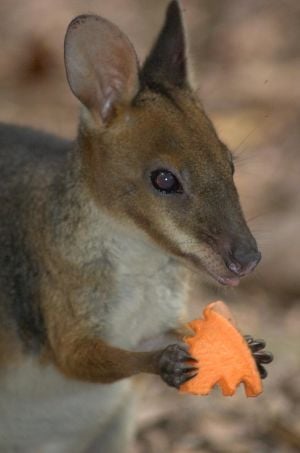

There are two subfamilies in the Macropodidae family: the Sthenurinae was highly successful in the Pleistocene but is now represented by just a single species, and a vulnerable one at that, the Banded Hare-wallaby; the remainder, about 60 species, makes up the subfamily Macropodinae.
- FAMILY MACROPODIDAE[3][4]
- Genus †Watutia
- Genus †Dorcopsoides
- Genus †Kurrabi
- Subfamily Sthenurinae
- Genus †Hadronomas
- Genus †Eosthenurus
- Genus †Sthenurus
- Genus †Procoptodon
- Genus †Nambaroo
- Genus †Wururoo
- Genus †Ganawamaya
- Genus †Balbaroo
- Genus †Silvaroo
- Genus Lagostrophus
- Banded Hare-wallaby, Lagostrophus fasciatus
- Subfamily Macropodinae
- Genus †Prionotemnus
- Genus †Congruus
- Genus †Baringa
- Genus †Bohra
- Genus †Synaptodon
- Genus †Fissuridon
- Genus †Protemnodon
- Genus †Troposodon
- Genus Dendrolagus: tree-kangaroos
- Grizzled Tree-kangaroo, Dendrolagus inustus
- Lumholtz's Tree-kangaroo, Dendrolagus lumholtzi
- Bennett's Tree-kangaroo, Dendrolagus bennettianus
- Ursine Tree-kangaroo, Dendrolagus ursinus
- Matschie's Tree-kangaroo, Dendrolagus matschiei
- Doria's Tree-kangaroo, Dendrolagus dorianus
- Goodfellow’s Tree-kangaroo, Dendrolagus goodfellowi
- Lowlands Tree-kangaroo, Dendrolagus spadix
- Golden-mantled Tree-kangaroo, Dendrolagus pulcherrimus
- Seri's Tree-kangaroo, Dendrolagus stellarum
- Dingiso, Dendrolagus mbaiso
- Tenkile, Dendrolagus scottae
- Genus Dorcopsis
- Brown Dorcopsis, Dorcopsis muelleri
- White-striped Dorcopsis, Dorcopsis hageni
- Black Dorcopsis, Dorcopsis atrata
- Gray Dorcopsis, Dorcopsis luctuosa
- Genus Dorcopsulus
- Small Dorcopsis, Dorcopsulus vanheurni
- Macleay's Dorcopsis, Dorcopsulus macleayi
- Genus Lagorchestes
- †Lake Mackay Hare-wallaby, †Lagorchestes asomatus
- Spectacled Hare-wallaby, Lagorchestes conspicillatus
- Rufous Hare-wallaby, Lagorchestes hirsutus
- †Eastern Hare-wallaby, †Lagorchestes leporides
- Genus Macropus
- Subgenus Notamacropus
- Agile Wallaby, Macropus agilis
- Black-striped Wallaby, Macropus dorsalis
- Tammar Wallaby, Macropus eugenii
- †Toolache Wallaby, †Macropus greyii
- Western Brush Wallaby, Macropus irma
- Parma Wallaby, Macropus parma (rediscovered, thought extinct for 100 years)
- Pretty-faced Wallaby, Macropus parryi
- Red-necked Wallaby, Macropus rufogriseus
- Subgenus Osphranter
- Antilopine Kangaroo, Macropus antilopinus
- Woodward's Wallaroo, Macropus bernadus
- Eastern Wallaroo, Macropus robustus
- Red Kangaroo, Macropus rufus
- Subgenus Macropus
- Western Grey Kangaroo, Macropus fuliginosus
- Eastern Grey Kangaroo, Macropus giganteus
- Subgenus Notamacropus
- Genus Onychogalea
- Bridled Nail-tail Wallaby, Onychogalea fraenata
- †Crescent Nail-tail Wallaby, †Onychogalea lunata
- Northern Nail-tail Wallaby, Onychogalea unguifera
- Genus Petrogale
- P. brachyotis species-group
- Short-eared Rock-wallaby, Petrogale brachyotis
- Monjon, Petrogale burbidgei
- Nabarlek, Petrogale concinna
- P. xanthopus species-group
- Proserpine Rock-wallaby, Petrogale persephone
- Rothschild's Rock-wallaby, Petrogale rothschildi
- Yellow-footed Rock-wallaby, Petrogale xanthopus
- P. lateralis/penicillata species-group
- Allied Rock-wallaby, Petrogale assimilis
- Cape York Rock-wallaby, Petrogale coenensis
- Godman's Rock-wallaby, Petrogale godmani
- Herbert's Rock-wallaby, Petrogale herberti
- Unadorned Rock-wallaby, Petrogale inornata
- Black-flanked Rock-wallaby, Petrogale lateralis
- Mareeba Rock-wallaby, Petrogale mareeba
- Brush-tailed Rock-wallaby, Petrogale penicillata
- Purple-necked Rock-wallaby, Petrogale purpureicollis
- Mt. Claro Rock-wallaby, Petrogale sharmani
- P. brachyotis species-group
- Genus Setonix
- Quokka: Setonix brachyurus
- Genus Thylogale
- Tasmanian Pademelon, Thylogale billardierii
- Brown's Pademelon, Thylogale browni
- Dusky Pademelon, Thylogale brunii
- Calaby's Pademelon, Thylogale calabyi
- Mountain Pademelon, Thylogale lanatus
- Red-legged Pademelon, Thylogale stigmatica
- Red-necked Pademelon, Thylogale thetis
- Genus Wallabia
- Swamp Wallaby or Black Wallaby, Wallabia bicolor
See also
- Australian megafauna
- Macropod hybrids
ReferencesISBN links support NWE through referral fees
- ↑ Poole, William E. (1984). in Macdonald, D.: The Encyclopedia of Mammals. New York: Facts on File, 862-871. ISBN 0-87196-871-1.
- ↑ The Paleobiology Database
- ↑ Cite error: Invalid
<ref>tag; no text was provided for refs namedmsw3 - ↑ Haaramo, M. (2004-12-20). Mikko's Phylogeny Archive: Macropodidae - kenguroos. Retrieved 2007-03-15.
Groves, C. (2005-11-16). in Wilson, D. E., and Reeder, D. M. (eds): Mammal Species of the World, 3rd edition, Johns Hopkins University Press, 58-70. ISBN 0-801-88221-4.
Lundie-Jenkins, G. 2004. Macropodidae. In B. Grzimek, D. G. Kleiman, V. Geist, and M. C. McDade, Grzimek's Animal Life Encyclopedia. Detroit: Thomson-Gale, 2004. ISBN 0307394913.
External links
}}
Credits
New World Encyclopedia writers and editors rewrote and completed the Wikipedia article in accordance with New World Encyclopedia standards. This article abides by terms of the Creative Commons CC-by-sa 3.0 License (CC-by-sa), which may be used and disseminated with proper attribution. Credit is due under the terms of this license that can reference both the New World Encyclopedia contributors and the selfless volunteer contributors of the Wikimedia Foundation. To cite this article click here for a list of acceptable citing formats.The history of earlier contributions by wikipedians is accessible to researchers here:
The history of this article since it was imported to New World Encyclopedia:
Note: Some restrictions may apply to use of individual images which are separately licensed.
